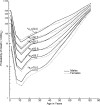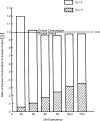Figure 2
Demographic Trends in Selected Countries Sources: England and Wales eighteenth century data (inset) and early nineteenth century data (to 1841) are Brownlee's estimates, cited by Glass, D. V., Population and Population Movements in England and Wales, 1700 to 1850, in Glass, D. V. and Eversley, D. E. C. (Editors), Population in History, Chicago, Aldine Publishing Company, 1965, pp. 221–246; data for 1841–50 and 1951–55 are from Glass, D. and Grebenik, E., World Population, 1800–1950, in Habakkuk, H. J. and Postan, M. (Editors), The Cambridge Economic History of Europe, Vol. VI, Cambridge, Cambridge University Press, 1965, pp. 56–138; data since 1955 are from Demographic Yearbook, 1963 and Demographic Yearbook, 1967, New York, United Nations. Data for Japan, 1900–04 to 1958 are from Taeuber, I., Japan's Demographic Transition Re-examined, Population Studies, 14, 28–39, 1960–61; data since 1958 from Demographic Yearbook, op. cit. Data for Chile, 1850–54 to 1960–64, are from Collver, O. A., Birth Rates in Latin America: New Estimates of Historical Trends and Fluctuations, Research Series No. 7, Berkeley, Institute of International Studies, University of California, 1965; data since 1962 from Demographic Yearbook, 1967, op. cit. Data for Ceylon, 1911–13 to 1936 are from International Vital Statistics, Vital Statistics Special Reports, 9, May 2, 1940; 1936–38 to 1946 data from Annual Epidemiologic and Vital Statistics, 1939–1946. Geneva, World Health Organization, 1951; data since 1947 from Demographic Yearbook, 1953, 1963, and 1967, op. cit.










